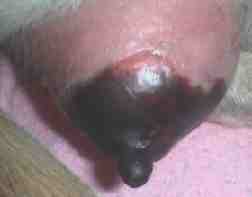
Mastitis in dogs is the inflammation of the mammary gland or glands that can occur in dogs shortly after giving birth. The inflammation can be sudden and severe, or it can be chronic and low-grade. It can involve a solitary mammary gland or multiple mammary glands can be affected. In this article, the signs, causes, diagnosis, treatment, and prevention of mastitis are discussed.
Contents
Mastitis in dogs, clinical signs
It may be difficult to detect mastitis in its earliest stages, since one of the first signs is that the puppies are not gaining as much weight as expected. This is due to the mother’s reluctance for the puppies to nurse due to discomfort, which can lead to a build up of milk in that mammary gland, causing more discomfort. The mammary glands may also be warm to the touch, slightly red and swollen, and a palpable mass may also be felt. Fever may also be present in the mother (normal rectal temperature range is 99.5-102.5 degrees Fahrenheit), and may be one of the earliest signs of mastitis.
The affected mammary gland or glands become increasingly swollen, hot, painful, and discolored (usually red or purple) as the mastitis progresses. The mammary glands may also develop ulcers; open wounds and scabs will become visible on the mammary gland. The milk expressed from the gland may be red or brown due to the presence of red and white blood cells, contain visible pus, or appear visibly cloudy or thickened in consistency.
As the mastitis continues to become more severe, the mother becomes increasingly reluctant to allow nursing and will start to neglect her puppies. The mammary gland may turn a dark purple or black in color as the tissues begin to die off from the infection and the decreased blood supply to the gland. The infection enters the bloodstream, causing the mother to become lethargic, feverish, reluctant to eat, and extremely painful. She may also start vomiting due to the bacterial toxins in her bloodstream.
For dogs with chronic low-grade mastitis, the only signs may be mild discomfort and puppies that don’t gain weight as quickly as expected.


Causes of mastitis in dogs
In most cases, mastitis is caused by a bacterial infection. The bacteria can enter the mammary gland through trauma that causes broken skin on the nipple or in the teat canal. The bacteria then enter the teat canal and travel up to the mammary gland where the infection takes hold. Dogs living in unsanitary conditions with large numbers of bacteria present in the environment may also become infected by bacteria making their way up the teat canal even without trauma to the nipple.
Less often, mastitis can occur without a bacterial infection. Inflammation of the mammary gland can occur with trauma to the mammary gland itself, or if there are long periods of time of milk build up without removal. Causes of milk build up include sudden weaning of the puppies causing excessive accumulation of milk within the gland or the death of a puppy, which leads to decreased milk removal from the glands.
Diagnosis of mastitis
Most mastitis cases can be diagnosed by physical exam and patient history. Your veterinarian may also recommend a few diagnostic tests to confirm the diagnosis, assess the severity of the infection, and/or choose an antibiotic that will be effective against the infection. A commonly recommended laboratory test is the complete blood count (CBC). This test measures the amount of red blood cells, white blood cells, and platelets present in the blood. Since white blood cells fight infection, the number and proportion of white blood cells present in the blood can indicate the presence of an infection and gives an idea of the severity of that infection.
A milk cytology may also be recommended to confirm a diagnosis of mastitis. In this test, a small amount of milk from the affected gland is examined under a microscope. If white blood cells or bacteria are present, this confirms the presence of an infection.
Another test that may be recommended is a bacterial culture and sensitivity of the milk from the affected gland(s). Milk is collected from the affected gland in a sterile manner and sent off to an outside laboratory for analysis. The laboratory will grow the bacteria and identify the species causing the infection. They will then test that bacteria against several different antibiotics and report back which antibiotics were most effective in killing the bacteria.
Treatment of mastitis
Most cases of mastitis can be treated on an outpatient basis, which means oral antibiotics such as cephalexin or Clavamox are prescribed, as well as possibly an opioid pain medication, to be given at home. At the proper dose, those particular medications are not harmful to the puppies who are nursing. If the bacterial culture and sensitivity tests indicate that an antibiotic harmful to the puppies must be used to clear the infection, it may be necessary to wean the puppies and provide them with formula instead.
Your veterinarian may also recommend hand-milking the affected gland, which would alleviate discomfort and allow proper blood flow to the mammary gland by relieving the pressure on the gland. Hand-milking can also reduce the risk of abscess formation and rupture of the mammary gland. To perform hand-milking, you’ll need a warm, damp cloth (above room temperature, but not hot enough to burn the mother’s skin), a couple of towels to soak up the expressed milk, and a little bit of soap, water, and towels to clean and dry the nipple. Have the mother find a comfortable position; usually laying down works best though standing may work as well. If you don’t want the puppies interfering, you may want to do this outside the whelping box.
Start by gently cleaning the nipple and surrounding area with some soap and warm water. Dry the area gently and thoroughly. Place the warm, damp cloth on the nipple for a few minutes to encourage let down of the milk and soften any material that might be blocking the teat canal. If you’re going to be expressing multiple glands, you can move the cloth to another nipple while you work on the first one. Gently grasp the nipple at the base of the breast between your thumb and the rest of your fingers. Once you’re comfortable, squeeze and gently pull towards the end of the nipple, away from the mother’s body. Milk should readily start flowing; if not, you may need to adjust your hand position. Squeeze gently until the milk slows to a trickle, then relax your hand without letting go, and squeeze and pull again. Repeat until the teat feels empty and is not producing as much milk. Hand-milking should be performed every six hours.
Compresses using a warm damp towel or chilled cabbage leaves may also be used to decrease pain and inflammation in the affected glands. Cabbage leaves have sulphur-containing compounds called glucosinolates which are converted to other compounds collectively called mustard oil, which has been used as a home remedy to reduce swelling. The cabbage leaves should be secured to the affected gland using a bandage or fitted shirt and then left in place for 2-4 hours. Remove the cabbage leaves for 3-4 hours, then reapply for another 2-4 hours. As long as pus is not being discharged from the nipple, the puppies can be allowed to nurse from the affected gland while it is uncovered; this will help with the healing process.
The affected glands should also be protected from trauma from the edges of the whelping/nest box, and especially from the toenails of the puppies. The puppies’ toenails should be kept trimmed; not only does it protect the mother’s delicate underbelly skin, it also gets the puppies used to having their feet handled and nails trimmed.
Most cases of mastitis have a good prognosis for recovery, and signs typically resolve in 2-3 weeks with appropriate treatment.
If the tissue of the mammary gland has sustained enough damage to start dying (become necrotic), your veterinarian will recommend surgical removal of the affected gland as soon as the mother is stable enough to undergo surgery. This procedure is known as a mastectomy.
If the bacteria have moved into the bloodstream and the mother is systemically ill (feverish, lethargic, not eating), she will need to be hospitalized for intravenous antibiotics, fluid support, and monitoring. If the infection has become severe enough to warrant hospitalization, the prognosis for recovery is guarded. Therefore prompt treatment of mastitis as soon as it is suspected and giving all medications and treatments as prescribed by your veterinarian will give the mother the best chance of recovery.
Prevention of mastitis
While it’s not possible to entirely prevent mastitis, there are several things you can do to limit the effects. The first is to keep the whelping/nesting box clean. Change out the bedding as necessary to keep it dry inside the box since moisture provides an excellent environment for the growth of bacteria. Pad the edges of the whelping box to prevent injury to the mother’s belly, and keep the puppies’ toenails trimmed. Carefully clean the mother’s teats with soap and water a few times a day, and while you are doing so, check the mammary glands for changes in temperature, firmness, skin color, and sensitivity to the touch. Gently express some milk to monitor changes in color or consistency. If you notice any changes in the glands or milk, be sure to have the mother examined and promptly treated before the inflammation and infection worsens.
Once a mother develops mastitis, she is more likely to do so with future litters. However tempting it might be to treat the mother with antibiotics in the hopes of preventing disease, doing so will likely cause the development of antibiotic-resistant strains of bacteria, making any infections that do occur more difficult to treat. The best course of action is to keep the environment clean and monitor the mother carefully for any signs of mastitis and seek treatment promptly. In severe cases, it may be prudent to consider having the mother spayed to prevent future problems.
References
- Petmd.com: Bacterial Infection of the Breast in Dogs